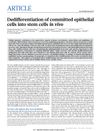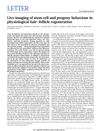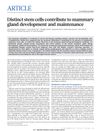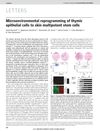TLDR Lineage tracing helps track cell development and has various methods with pros and cons.
Lineage tracing was a crucial method in developmental biology and stem cell biology, allowing researchers to track the progeny of individual cells. The document introduced the principles of successful lineage-tracing experiments and compared various methods used in the process. It provided examples of how these strategies were applied to address fundamental questions in development and regeneration. Additionally, the document discussed the advantages and limitations of each lineage-tracing method.
 551 citations
,
November 2013 in “Nature”
551 citations
,
November 2013 in “Nature” Certain mature cells in mouse lungs can turn back into stem cells to aid in tissue repair.
394 citations
,
October 2013 in “Nature”  305 citations
,
June 2012 in “Nature”
305 citations
,
June 2012 in “Nature” Hair regeneration needs dynamic cell behavior and mesenchyme presence for stem cell activation.
 721 citations
,
October 2011 in “Nature”
721 citations
,
October 2011 in “Nature” Different types of long-lasting stem cells are responsible for the growth and upkeep of the mammary gland.
 116 citations
,
August 2010 in “Nature”
116 citations
,
August 2010 in “Nature” Scientists turned rat thymus cells into stem cells that can help repair skin and hair.
503 citations
,
May 2009 in “Cell stem cell” Lrig1 marks a unique group of stem cells in mouse skin that can become different skin cell types.
1279 citations
,
November 2005 in “Nature Medicine”



